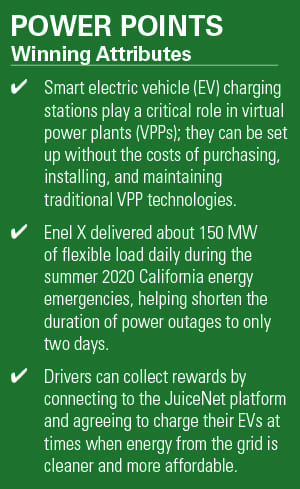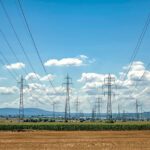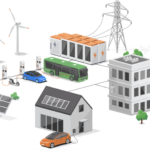 |
The need for demand response programs, particularly those that help stabilize the grid, is evident as electricity customers seek a more reliable power supply. Enter virtual power plants (VPPs), a way for communities to take a lead role in their electricity usage. A VPP proved its mettle during California’s power emergency in 2020.
The virtual power plant (VPP) is one of many forms of decentralized power generation. Its place in the electricity hierarchy is often debated; some call it a supply-side initiative, others consider it an important tool for demand response, where it already has proven its worth.
There’s certainly agreement about the importance of VPPs to the future of the electricity sector. The past few years have brought a flurry of activity in the VPP market, as utilities and energy providers worldwide invest in technologies that are changing business models and hold the promise of making the power supply more reliable and resilient.
Enel X is the advanced energy services business line of Italian energy giant Enel. The company in North America manages about 4.7 GW of demand response, with more than 70 battery storage projects in operation and contracted, along with more than 70,000 smart electric vehicle (EV) charging stations.
An Enel X program in California is a prime example of the services a VPP can provide. The project, which serves a variety of customers, is what Enel X calls “a roughly 70 MW highly distributed” VPP. The VPP is active in the California Independent System Operator (CAISO) wholesale day-ahead and real-time markets, “dynamically managing charging loads to balance grid demand, reduce wholesale energy costs, and mitigate the intermittency of renewables.”
Just like traditional thermal power plants, which supply electricity capacity when needed and also deliver grid-stabilizing ancillary services, VPPs have the potential to bring revenue from those operations as well.
“Looking to the future of energy distribution and the growth of renewables, VPPs provide a necessary method of flexible, decentralized power generation to make renewable energy more affordable and more reliable,” Giovanni Bertolino, head of e-Mobility for Enel X North America, told POWER. “As we consider the growth of urban markets and growing population density, they are also an efficient way to relieve the strain placed on the grid during peak usage times in high-population areas. As we continue the move toward renewable energy, VPPs will remain important as an efficient, cost-effective way to balance generation and consumption.”
An Award-Winning Project
The California VPP, honored by POWER with its 2021 Distributed Energy Award, is optimized by Enel X’s cloud-connected JuiceNet software, which enables the company to deliver valuable grid services—such as demand response capacity—on a daily basis across the state.
“JuiceNet is a cloud-based IoT [Internet of Things] platform for EV charging, load management and optimization. It matches historical charging patterns, real-time input, and signals from operators and utilities to aggregate and manage electric vehicle charging station demand,” said Bertolino. “The platform provides users with smart grid control and revenue opportunities, while contributing long term to improved grid reliability and economics as well as local air quality and decreased emissions.”
The importance of the VPP was highlighted during the energy emergencies in California in the summer of 2020. “In California, Enel X’s VPP is comprised of multiple flexibility assets including smart EV charging stations, C&I [commercial and industrial] demand response, and battery storage,” said Bertolino. “During the energy emergencies in California… Enel X worked with its commercial customers and EV drivers to curtail energy usage during periods of peak demand through demand response. Across its portfolio of smart EV chargers, commercial and industrial demand response, and battery storage projects, Enel X delivered around 150 MW of flexible load daily during the emergencies and helped shorten the duration of power outages to only two days.”
Demand Response
Most of California’s demand response programs were activated during the August 2020 emergency, including several across the territories of Southern California Edison (SCE) and Pacific Gas & Electric (PG&E), as soaring temperatures brought greater power demand. Rolling blackouts, which were initiated on Aug. 14 and continued across that weekend, highlighted the need for more reliable power, as the state experienced four of its five hottest August days since 1985.
 |
|
1. Enel X’s JuiceBox smart charger is an integral part of the company’s virtual power plant program. It can be deployed in both residential and commercial settings; in this instance, on the wall of a garage for easy vehicle access. Courtesy: Enel X |
As an example of the VPP, Sonoma Clean Power dispatched its GridSavvy Community, an area that includes more than 900 EVs, along with several smart thermostats and heat pump water heaters, to coincide with the Flex Alert—a voluntary call for electricity customers to curtail their energy use—and grid operator CAISO’s forecast peak demand. Smart technologies, including Enel X’s JuiceBox smart charger (Figure 1), automatically responded.
“We’d like to recognize Sonoma Clean Power for dispatching its GridSavvy Community,” said Bertolino. “With automated response of the smart technologies like the JuiceBox smart EV charging station, Sonoma Clean Power is leveraging the GridSavvy Community to help spread the word on behavioral changes that can help relieve stress on the grid.”
Enel X said that during the energy emergency, from the afternoon of Aug. 14 through Aug. 18, it had about 20 hours of dispatch across eight zones in California, “activating JuiceNet-enabled smart home chargers without any necessary human intervention. The average dispatch event duration to JuiceNet customers was just more than 3.6 hours per day, with event participation rates above 90%. High participation rates can be attributed to the Enel X JuicePoints program that rewards consumers for participating in dispatch events.” Enel X during the Flex Alert activated a larger share of the company’s smart EV charging virtual-battery to voluntarily reduce strain on the entire California grid.
A post-mortem report on the energy emergency from three groups, including CAISO, the California Energy Commission, and the California Public Utilities Commission (CPUC), said that the effort from everyday electricity consumers, including those involved in the VPP, helped the state avoid even more blackouts in the days following the August heatwave.
“As the country’s most populous state, California consumes massive quantities of energy every day,” said Bertolino. “VPPs help balance demand with supply, reduce wholesale energy costs, and optimize the consumption of renewables based on their availability on the grid. Additionally, because California regularly experiences severe environmental events that underscore the critical need for energy resiliency, VPPs can moderate energy use via demand response, decreasing the duration of power outages.”
State officials in the wake of the emergency acknowledged the need to prepare for future, similar peak power demand situations. “The extreme heat storm in August was an extraordinary 1-in-35-year event that, with climate change, is unfortunately becoming more common,” said Marybel Batjer, president of the CPUC, in a statement days after the heatwave.
 |
‘Critical Role’
Enel X has deployed VPPs around the world. A VPP project in Australia includes participation from Echuca Regional Health, a hospital that features one of the largest solar thermal arrays in that country. The array provides heating for the hospital, along with absorption cooling for the facility’s high-efficiency air conditioning system. The hospital has utilized its backup generators to participate in a VPP since 2017, to, among other things, earn new revenue that can be reinvested into backup power infrastructure to further enhance system reliability. It’s also a critical element to guard against grid instability—which is a major feature of VPPs, including the Enel X project in California.
“Smart EV charging stations have the ability to play a critical role in VPPs because they can be set up without the costs of purchasing, installing, and maintaining traditional VPP technologies (since the systems are often purchased by consumers),” said Bertolino. “With JuiceNet, charging is optimized based on grid conditions including energy demand. Looking ahead, an electric vehicle with vehicle-to-grid capability could not only receive power, but could also pull it from the car’s EV battery pack, supplying it back to buildings and other infrastructure, creating a bidirectional charging flow. The future of EV charging will also include large-scale demand response programs across the U.S., which will further impact reliability.”
Ancillary services are also important. “The JuiceNet platform not only powers the Enel X family of JuiceBox charging stations, it offers smart grid control and revenue opportunities for our global partners, including automakers, EVSE [electric vehicle supply equipment] manufacturers, businesses, and utilities,” said Bertolino. “The platform offers the ability to set charging times, cap overall consumption, and manage demand charges to increase the bottom line and ROI [return on investment] for EV charging infrastructure.”
As more communities and energy providers embrace smart technologies, and power generation becomes more decentralized, expect the deployment of VPPs to grow.
“VPPs are emerging as the power systems of the future. Energy demand is increasing worldwide, and as we account for that growth and the transition to renewable energy, the need for flexible and cost-effective energy generation couldn’t be more pressing,” said Bertolino. “VPPs reduce the need for utilities to make costly infrastructure upgrades and provide an opportunity for them to engage their customers. EV drivers can capture financial incentives while reducing stress on the grid to strengthen it and improve resiliency.” ■
—Darrell Proctor is a senior associate editor for POWER (@POWERmagazine).










